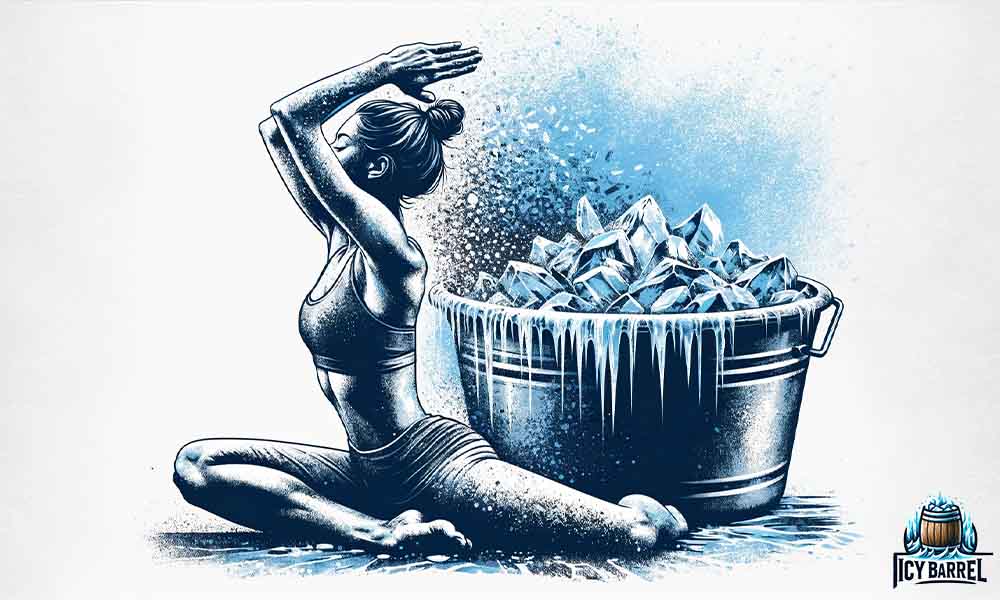When considering the optimal recovery process, you might wonder whether it’s better to stretch before or after an ice bath. While athletes and fitness enthusiasts often turn to ice baths to constrict blood vessels, flush waste products, and reduce swelling and tissue breakdown, the relationship between stretching and ice baths remains less clear.
Several sources recommend waiting at least 30-40 minutes after an ice bath before engaging in stretching exercises. This allows your muscles to recover and warm up while blood flow returns to normal. Warming up with a warm shower or hot drink before stretching can also be beneficial.
Choosing the appropriate attire for your ice bath is essential for staying comfortable and safe during your recovery ritual. It’s also crucial to consider how ice baths can positively impact your mental health, potentially boosting your mood, reducing stress, and increasing mental resilience. Overall, understanding the relationship between stretching and ice baths can help maximize recovery and improve your overall well-being.
Significance of Ice Baths & Stretching

Ice baths have long been a popular practice among athletes and fitness enthusiasts, offering a variety of health benefits. The main purpose of an ice bath is to aid in muscle recovery and soothe soreness after intense workouts or physically demanding activities. Submerging your body in cold water helps reduce inflammation, constrict blood vessels, and flush out waste products, thus promoting faster recovery.
Another aspect to consider when preparing an ice bath is the optimal water temperature. Research suggests that cold water immersion with temperatures between 50-59°F (10-15°C) delivers the most effective benefits, such as improved exercise recovery, mental resilience, and enhanced sleep quality.
Taking ice baths not only assists in physical recovery, but also contributes to mental health benefits. Exposure to cold temperatures forces your body to adapt, helping you build mental resilience and develop a stronger mind-body connection. When you consistently push your limits in this manner, you’ll notice an increase in your ability to handle stress and maintain mental clarity.
However, timing is important when incorporating ice baths into your routine. It’s crucial to find a balance between stretching and ice baths to optimize their effectiveness. Stretching promotes flexibility and increases blood flow to your muscles, while ice baths work to reduce inflammation and aid recovery. By understanding the relationship between these practices, you can develop a more efficient post-workout routine.
Should You Stretch Before or After Ice Bath?

If you are investing time and effort into ice baths for recovery and well-being, it’s essential to know the most effective way to incorporate stretching. You may wonder whether stretching should be done before or after an ice bath to optimize its benefits.
After an ice bath, your muscles and blood vessels are constricted due to cold temperatures. As they warm up, blood flow increases, speeding up the healing process. With this in mind, it is generally recommended to stretch after an ice bath to provide optimal recovery. Stretching after the ice bath allows your body to take advantage of the enhanced blood flow and can help increase flexibility while reducing muscle soreness.
You can complement your ice bath with light active recovery exercises, such as yoga or dynamic stretches. These additional activities promote better overall recovery and help you gain maximum benefits from your ice bath session. Remember to keep your stretches gentle and slow as part of your post-ice bath routine.
While there is no clear indication that stretching before an ice bath is harmful, it is less effective in maximizing recovery. However, if you choose to stretch before the ice bath, ensure your muscles are warm and adequately prepared for the upcoming cold plunge.
In conclusion, stretching after an ice bath allows you to reap the most benefits from your recovery routine. By following this approach, you’re more likely to experience reduced muscle soreness and enhanced flexibility. Adjust your regimen according to your individual goals and preferences to ensure you optimize your ice bath sessions.
Benefits and Risks of Stretching Before Ice Bath

Benefits:
- Mental Preparation: Stretching before an ice bath can help you mentally prepare for the cold immersion, increasing your focus and allowing you to mentally brace yourself for the sudden temperature change.
- Flexibility Maintenance: Stretching before the ice bath can help maintain your flexibility, as cold water immersion may cause muscle stiffness. Stretching prior to this therapy helps keep your muscles limber and prepared for any potential stiffness.
- Reduced Perceived Effort: Cold therapy has been shown to decrease the perception of effort during exercise. By stretching before an ice bath, you can enhance this effect and help your body push harder and tolerate higher intensities in your workouts.
Risks:
- Overstretching: Stretching before an ice bath may lead to overstretching if not done correctly. Overstretching can cause strains and increase the risk of injury. Be mindful of your body’s limits and perform gentle stretches instead of forcing your muscles beyond their comfortable range of motion.
- Inadequate Recovery Time: Stretching too close to your ice bath session may not provide your muscles with ample time to recover and warm up. Some experts recommend waiting at least 30-40 minutes after an ice bath to allow your muscles to recover, warm up, and blood flow to return to normal before stretching.
In summary, stretching before an ice bath can provide both mental and physical benefits, such as mental preparation, flexibility maintenance, and reduced perceived effort during exercise. However, risks like overstretching and inadequate recovery time should be considered and addressed appropriately. By being mindful of these factors and practicing proper stretching techniques, you can maximize the benefits of your pre-ice bath stretching routine.
Upsides and Downsides of Stretching After Ice Bath

Recovery Enhancement
One potential benefit of stretching after an ice bath is its ability to enhance the recovery process. By pairing low-impact stretching exercises with the ice bath’s therapeutic effects, you are supporting your body in reducing inflammation and speeding up muscle healing. Additionally, it is worth noting that the cold temperature can make your muscles less flexible, so stretching after an ice bath can aid in restoring their flexibility and range of motion.
- Improved muscle recovery: By stretching after an ice bath, you can help your muscles recover faster from exercises.
- Increased flexibility: Cold temperatures may reduce muscle flexibility, so gently stretching afterward can get your muscles back to their normal level of flexibility.
Potential Muscle Damage
On the downside, stretching after an ice bath can, in some cases, lead to potential muscle damage. This is because your muscles may be more prone to injury, as they are less elastic due to the exposure to cold temperatures. Additionally, it can be harder to gauge your true range of motion in a cold state, which may make it more difficult to avoid overstretching your muscles during post-ice bath stretches.
- Increased risk of injury: Your muscles may be less elastic after an ice bath, which could lead to potential injuries during stretching.
- Difficulty gauging flexibility: A cold muscle might not stretch as smoothly, making it difficult to determine your real range of motion and avoid overstretching.
In conclusion, stretching after an ice bath has both upsides and downsides. To make the most of both techniques, carefully plan your stretching routine and ensure that you prioritize safe, gentle stretches that enhance your recovery without risking further injury.




